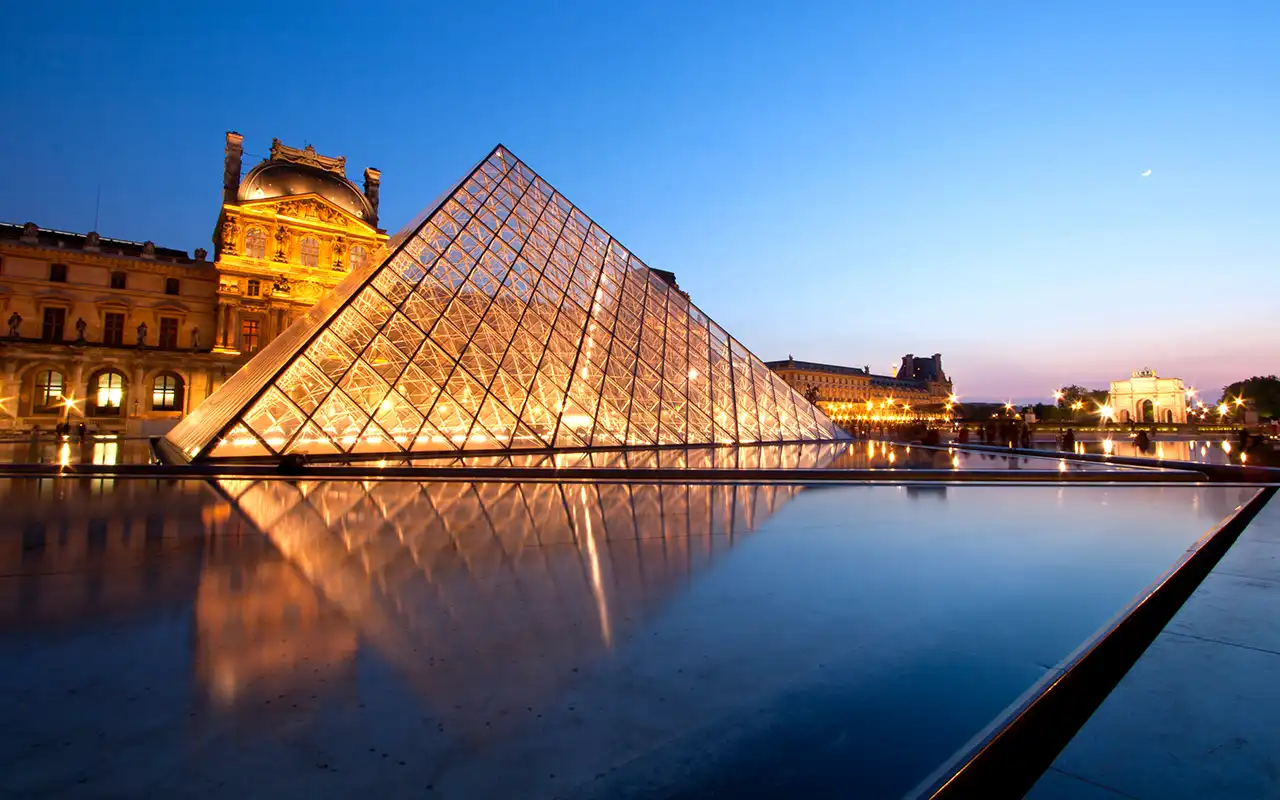
Navigating The Louvre Museum : Answers to common questions
- Hours of Operation: Monday,Wednesday,Thursday,Saturday and Sunday 9:00 AM to 6:00 PM Friday 9:00 AM to 9:45 PM Tuesday Closed
- Admission Fee: General admission €22 Children under 18 and EEA residents under 26 Free admission.
- How Long to Visit: It takes a minimum of 2 hours to see the major pieces such as the Mona Lisa. It would take upwards of a full week to view the entire museum.
- Handicap Accessible: Yes, wheelchair friendly.
- Pets: Service animals welcome.
- Guided Tours: Guided tours are available for The Louvre.
- Parking: Limited availability.
- Family Friendly: Family friendly for all ages.
- Photography: Permitted. No flash inside the museum.
Please note all times and prices subject to change. Please check the offical website for details.
The Louvre Museum, located in Paris, France, is one of the world's largest and most iconic art museums. Known for its stunning architecture and impressive collection of over 350,000 artifacts, the Louvre attracts millions of visitors every year. Let's delve into the fascinating history of the Louvre, highlight key features and exhibits within the museum, and explore the impact it has had on the world of art and beyond.
Historical Overview of the Louvre
The history of the Louvre can be traced back to the 12th century when it was originally constructed as a fortress under the rule of King Philippe Auguste. Over the centuries, the building has undergone various transformations, including becoming a royal palace in the 16th century. It was during the reign of King Louis XIV that the palace began to house the royal art collection. In 1793, with the initiative of the French Revolution, the Louvre officially became a public museum.
Over the centuries, the Louvre has seen multiple expansions and renovations, resulting in its current sprawling layout. The infamous glass pyramid at the entrance was designed by renowned architect I.M. Pei and completed in 1989, symbolizing a perfect union of the historical and modern aspects of the museum.
Major Sections and Collections of the Louvre Museum
The vast collection of the Louvre Museum is organized into several departments, divided by historical periods and artistic disciplines. Each department houses outstanding works of art and antiquities that are revered by art enthusiasts and historians alike.
Egyptian Antiquities
The Louvre boasts one of the largest Egyptian antiquities collections outside of Egypt itself. This department contains over 50,000 pieces, spanning from the Pre-dynastic period to the Christian era. Notable works include the Seated Scribe, the statue of Pharaoh Ramses II, and the famous Dendera Zodiac.
Near Eastern Antiquities
This department showcases the rich history and diverse cultures of the ancient Near East, encompassing areas such as Mesopotamia, Persia, and the Levant. Highlights of this collection include the Code of Hammurabi, the colossal Lamassu from the Assyrian city of Khorsabad, and the breathtaking Ishtar Gate from Babylon.
Greek, Etruscan, and Roman Antiquities
Pieces from ancient Greece, Rome, and Etruscan civilizations make up this remarkable department. Among the notable works are the Venus de Milo, the Winged Victory of Samothrace, and the Borghese Gladiator. Additionally, this section houses an impressive collection of Greek vases, Roman frescoes, and intricate jewelry.
Sculptures
The Sculptures department contains a vast array of works, primarily from Western Europe, dating from the early Middle Ages to the mid-19th century. The collection features masterpieces such as Michelangelo's Dying Slave, Donatello's David, and Jean de Fiennes' famous Rodin statue. The museum's famed collection of sculptures also includes many Gothic, Renaissance, and Baroque works.
Decorative Arts
The Louvre's Decorative Arts department includes objects such as ceramics, glassware, furniture, and textiles from the Middle Ages to the first half of the 19th century. It showcases the opulence, craftsmanship, and innovative techniques of artisans throughout centuries. Key pieces include the Writing Cabinet of King Louis XIV, the Sevres Porcelain Dinner Service, and the stunning Crown Jewels of France.
Paintings
With over 7,500 works, the Paintings department is one of the Louvre's most famous attractions. Featuring masterpieces from the 13th to the 19th centuries, it includes iconic pieces such as the Mona Lisa by Leonardo da Vinci, Liberty Leading the People by Eugène Delacroix, and The Coronation of Napoleon by Jacques-Louis David.
Prints and Drawings
Though not always on display due to preservation concerns, the Louvre's Prints and Drawings department contains over 140,000 works. The collection includes masterpieces by artists such as Rembrandt, Dürer, and Michelangelo, as well as rare sketchbooks, manuscripts, and engravings.
Islamic Art
Established in 2003, the Islamic Art department exhibits over 3,000 works from a vast geographical area that spans three continents. The collection encompasses decorative arts, paintings, textiles, and architectural elements from the 7th to the 19th centuries. Highlights include the Great Mosque Lamp of Cordoba and the incredible Persian manuscript, the Shahnama.
The Louvre Museum's Impact on Art and Culture
Since its establishment as a public museum in 1793, the Louvre has not only offered visitors access to its unparalleled art and antique collections, but it has also significantly influenced the world of art and culture. The museum has served as a prime example of successful cultural preservation, proudly showcasing artifacts from various civilizations and eras. The Louvre's vast and diverse art pieces have inspired countless artists, scholars, and visitors throughout the years.
Furthermore, the Louvre Museum has played a significant role in promoting accessible and inclusive art experiences for people from all walks of life. With its ever-evolving exhibits, extensive collections, and educational programs, the Louvre continues to foster an appreciation for art and cultural history both within France and around the world.
The Louvre Museum is an iconic institution that has played a significant role in the preservation and promotion of artwork throughout history. It is a treasure trove of art and culture spanning multiple civilizations and eras. Any visit to Paris is incomplete without a visit to this world-renowned museum, ensuring that the Louvre will continue to inspire and captivate art enthusiasts for generations to come.
More in our list of Things To Do In Paris
;Palais-Royal Current Weather
Local Temp: 17.6℃ / 63.7℉
High: 19℃ / 66.2℉
Low: 16.3℃ / 61.3℉
Humidity: 63 %
Local Time: 11:52
Map for The Louvre Museum
Did You Know?
The glass pyramid of the Louvre, designed by architect I.M. Pei and inaugurated in 1989, is one of Paris's most iconic landmarks. It serves as the main entrance to the museum and has become a symbol of the blend between the Louvre's historic architecture and modern design.
The Louvre was temporarily closed during World War II, and its artworks were moved to various locations across France to protect them from Nazi looting. This monumental effort ensured the safety of thousands of invaluable pieces, including the "Mona Lisa."
The Louvre's collection includes the "Mona Lisa," arguably the most famous painting in the world. Painted by Leonardo da Vinci in the 16th century, it's known for its enigmatic smile and the mystery surrounding the identity of its subject.
The Louvre was originally built as a fortress in 1190 by King Philip Augustus to protect Paris from Viking raids. It was later transformed into a royal palace in the 16th century before becoming the magnificent museum we know today.
The Louvre is the world's most visited museum, attracting millions of visitors each year. Its vast collection spans over 9 million objects, including artworks and artifacts from ancient civilizations to mid-19th century masterpieces.
Travel Information for
Paris Visitors
Time Zone: Paris operates on Central European Time (CET), which is 1 hour ahead of Greenwich Mean Time (GMT+1).
Weather: Paris has a Western European oceanic climate. The summers are generally warm and pleasant with average temperatures between 15 to 25 degrees Celsius (59 to 77 degrees Fahrenheit). Winters are cold with temperatures often dropping to around 1 to 7 degrees Celsius (34 to 45 degrees Fahrenheit). Rain is fairly distributed throughout the year, with light showers more common.
Population: Paris has a population of over 2 million people within its administrative city limits. The wider Paris metropolitan area has a population of around 12 million, making it one of the largest urban areas in Europe.
Size: Paris covers an area of about 105 square kilometers (40.7 square miles). Despite its relatively small size, the city is densely populated and is divided into 20 districts, known as arrondissements.
Language: The official language is French. While many Parisians speak English, especially in tourist areas, learning a few basic French phrases can be helpful and is appreciated by the locals.
Currency: France uses the Euro (€). Credit cards are widely accepted, but it's always a good idea to have some cash, especially for smaller purchases in bakeries, open markets, or in areas less frequented by tourists.
Safety: Paris is generally considered safe for tourists. Like any major city, it's advisable to be aware of your surroundings and take standard safety precautions, especially in crowded areas and on public transportation.
Tipping: In Paris, a service charge is usually included in the bill at restaurants. However, it's customary to leave a small extra tip if you're happy with the service.
Electricity and Plugs: France uses Type C and Type E plugs, and the standard voltage is 230 V with a standard frequency of 50 Hz. Travelers from countries with different electrical standards may need adapters.
Water: Tap water in Paris is safe to drink. Many cafes and restaurants will serve tap water for free if requested.
Verified & Trusted Contact Information for The Louvre Museum
Address:
75001 Paris, France
Website: www.louvre.fr/
Latitude: 48.8606
Longitude: 2.3376
More Places and Things To Do in Paris Within 500 km/300 mi of The Louvre Museum
Shakespeare and Company Bookstore

The Distance from The Louvre Museum to Shakespeare and Company Bookstore is 1.1 KM / 0.7 MI
Bastille Day Celebrations

The Distance from The Louvre Museum to Bastille Day Celebrations is 2.5 KM / 1.5 MI




















